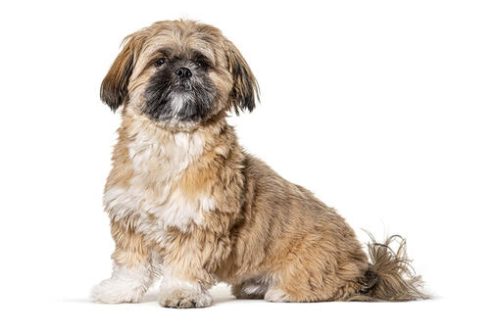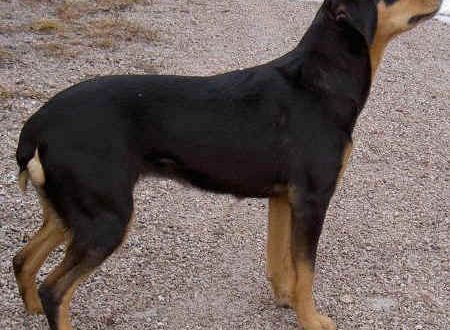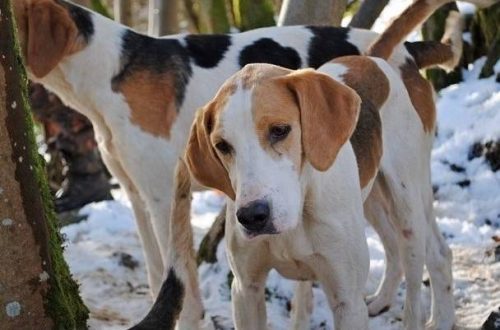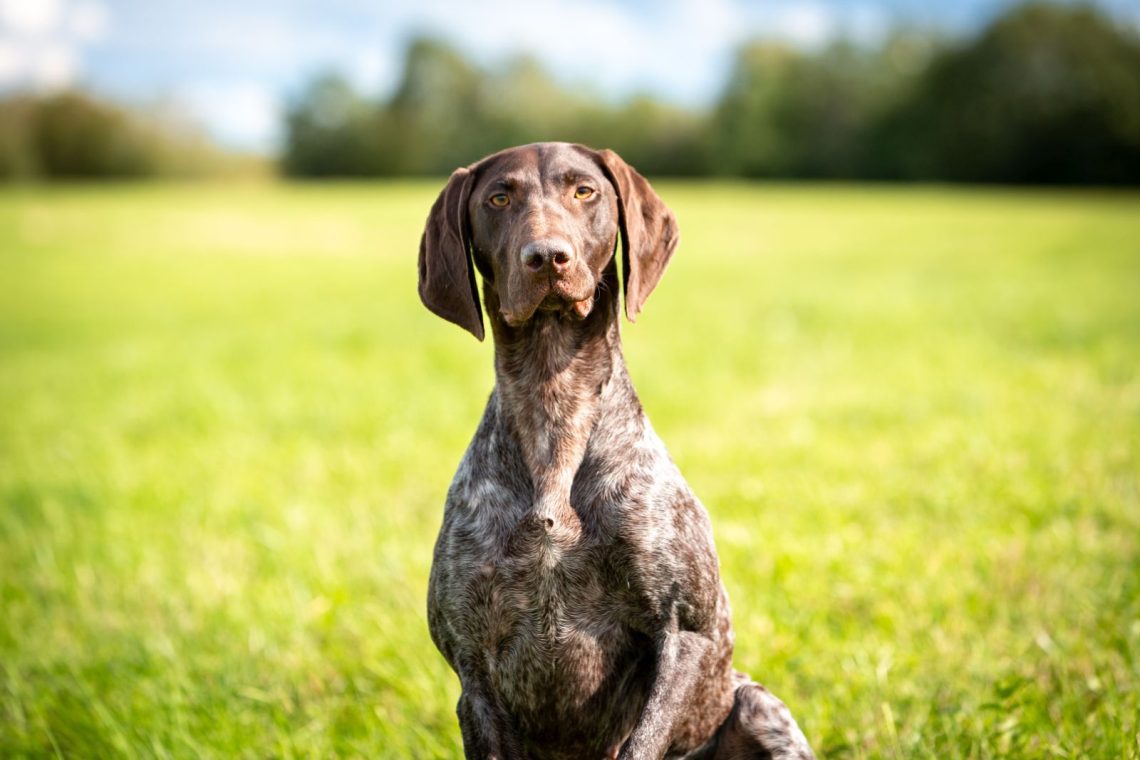
Kurzhaar
Other names: German shorthaired pointer , German shorthaired hound
Kurzhaar is a clockwork toy that knows no rest. The energy of the dog is in full swing, involving it in adventures. This is a versatile hunting breed, the skills of which are easy to find application.
Contents
- Characteristics of Kurzhaar
- Basic moments
- History of the Kurzhaar breed
- Video: Kurzhaar
- Appearance of a shorthaired pointer
- Photo of kurtshaar
- The character of the shorthaired pointer
- Education and training
- Care and maintenance
- Health and disease of the kurtshaar
- How to choose a puppy
- Photos of kurtshaar puppies
- How much is a kurtshaar
Characteristics of Kurzhaar
| Country of origin | Germany |
| The size | large |
| Growth | 58-66 cm |
| Weight | 20–32 kg |
| Age | 12–14 years old |
| FCI breed group | cops |
Basic moments
- Kurzhaar is a real bundle of energy on four legs! His minimum requirement is an hour of active physical exercise, and this is far from the limit.
- Animals can catch game in any conditions, so they become indispensable companions for hunting adherents.
- Representatives of the breed can not stand loneliness. Regular absence of the owner can provoke mental health problems in the dog.
- Shorthaired pointer rarely shows aggression towards strangers. For this reason, it is difficult to make a good watchman out of him.
- Dogs make friends with children of all ages. However, you should not leave a cheerful couple unattended: the animal may accidentally push the child.
- Shorthaired Pointers get along well with other pets, but refrain from introducing them to decorative rodents and birds.
- Animals are not always comfortable in the apartment. They feel better in a private house with a spacious yard where you can warm up to your heart’s content.
- The breed is suitable only for experienced dog breeders.
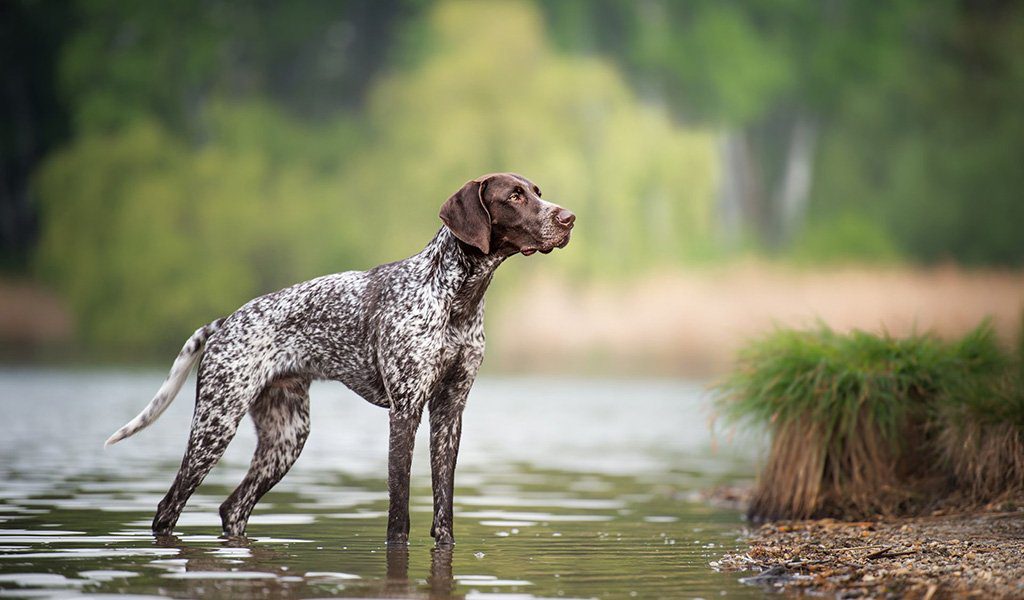
Kurzhaar is the choice of activists who are crazy about jogging and walking in the company of a four-legged friend. The playfulness and enthusiasm of the dog make it a great companion. The animal will find a common language with both an adult and a child, who needs an eye and an eye. The kurtshaar will not leave the hunter indifferent either: this breed is always in its element – on land and in water! The dog will not be frightened by either the mating season of partridges or the strong antlers of deer. However, the fearlessness of the shorthaired pointer will come to naught before the chance to spend the whole day alone. The regular absence of the owner of the house disposes the animal to a vivid protest. It manifests itself in damaged interior items and aggressive behavior of the dog.
History of the Kurzhaar breed
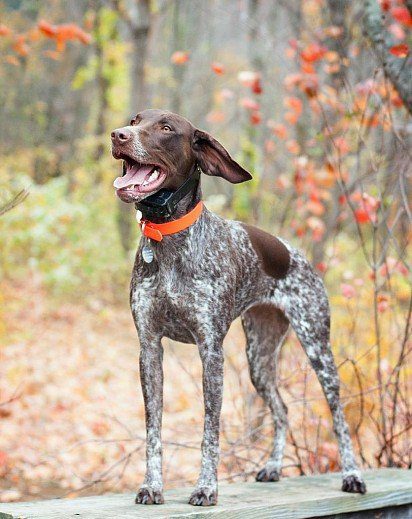
Initially, cynologists believed that the ancestors of kurtshaars inhabited the territory of Germany since time immemorial. Then they were kept by representatives of the German and Austrian nobility for hunting on their lands. However, the facts more and more often indicate that the progenitors of the breed were brought to Germany from the Mediterranean, where they got, in turn, from the countries of sunny Asia.
The invention of firearms was a turning point, after which the attitude of Europeans towards hunting dogs changed. Prior to this, the breeds were divided into three types. So, greyhounds were used for baiting big game: wild boars, wolves or deer. The hounds were ideal for hunting medium-sized prey that could develop tremendous speed: hares or rabbits. The cops were valued for their ability to find wild birds and other small animals in dense thickets.
It was to the latter type of hunting dogs that the Bracco Italiano and the Spanish Pointer (Perdigero Burgos) belonged – the progenitors of the shorthaired pointers. The first breed came to Germany in the 15th century and immediately became fertile ground for crossing with the Hanoverian Hound. From the latter, the kurtshaars inherited a uniform coffee color and excellent hunting skills for game of any size.
The Perdigero Burgos, the “Spaniards”, who were bred to hunt partridges, had no less influence. These dogs came to Germany three centuries later, but still managed to make their contribution. The union of the Spanish Pointer and Bracco Italiano was the Old German Wurtenberg Hound, the closest ancestor of the Shorthaired Pointer.
There is an assumption that not only Bracco Italiano and Perdigero Burgos participated in the selection of the breed. Among the possible progenitors of the shorthaired pointer are the English Pointer, Weimar Hound, Hungarian Vizsla, Dalmatian and German Hounds. At the same time, the exterior was not considered the main criterion for selecting specimens for mating. Working qualities were more important: at that time, capable dogs with excellent flair cost almost more than a thoroughbred horse.
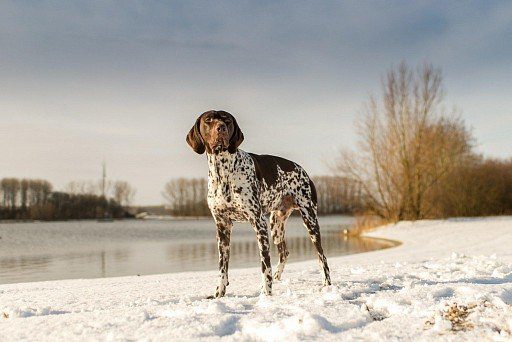
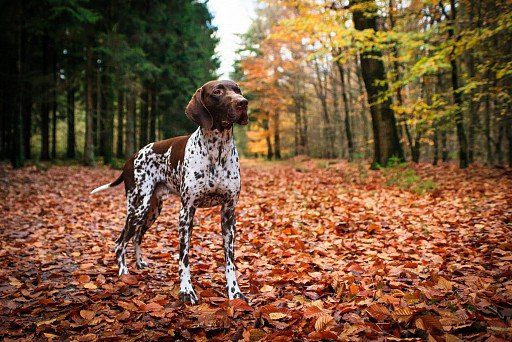
At the beginning of the 18th century, a “wave of standardization” swept European countries – the desire of breeders to create studbooks for dogs and develop criteria for local breeds. At the same time, the drathaar appeared – the result of crossing wire-haired dogs with German pointers. To distinguish the latter from the Drathaars, the breeders decided to give the breed a new name. So the German smooth-haired pointer became a kurtshaar. From the second half of the 19th century, breeders of the new breed began to create studbooks. Already in 1872, the shorthaired pointer was included in the lists of the GKC – the German cynological society.
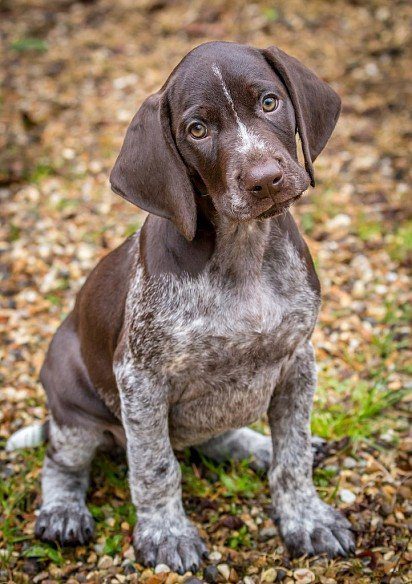
Representatives of the breed increasingly appeared at exhibitions, however, only as service dogs. The Hanoverian prince Albrecht zu Solms-Braunfeld gave generous rewards to many breeders of their favorite animals. On his own initiative, at the end of the 19th century, the Stud Book of the German Shorthaired Pointer was published. It included detailed information about the breed, its description, the first standard and a list of hunting “tests” that these animals cope with without difficulty.
Reliable information regarding the external appearance of kurtshaars of that time has not been preserved. Only in 1912 was the breed standard officially fixed. Crossing with pointers made the dogs more refined and faster, which had a positive effect on the hunting process.
In 1925, representatives of the breed first saw the lands of the United States. Charles Thornton – one of the American breeders – was subdued by the appearance and working qualities of shorthaired pointers. This prompted him to take several representatives of the breed with him and actively engage in their breeding. Already in 1930, the American Kennel Club recognized and registered kurtshaars. The peak of their selection falls on the middle of the 20th century. The breed is increasingly found at dog shows, and some of its representatives – and on the pages of book works.
The same cannot be said about the breeding of kurtshaars in Europe. The Second World War threatened the further development of the breed. Together with the acquired property, the breeders exported the best hunting dogs to Yugoslavia. This greed almost interrupted the German kurtshaar branch: the Iron Curtain limited the access of German breeders to worthy representatives of the breed. In this regard, breeders were forced to restore the number of kurtshaars with the help of those dogs that were at their disposal.
In 1948, the English Kennel Club registered the breed, referring it to gunmen. Twenty years later, kurtshaars became one of the most common hunting dogs. Even at the beginning of the 21st century, this breed occupied the sixteenth position in the AKC list.
Russia was no exception and also succumbed to the charm of kurtshaars. Hunters appreciated the versatile working qualities of the breed, which allow them to track down any game. However, now kurtshaars are mostly made as devoted and active friends. The popularity of hunting has disappeared, and with it the need for a fast companion with excellent instincts. The only thing that remained unchanged was the desire of the kurtshaars to frolic in the fresh air and please the owner with a correctly performed exercise.
Video: Kurzhaar
Appearance of a shorthaired pointer
The kurtshaar is a large dog breed. He is gracefully built and athletic. The body of the animal is distinguished by strong muscles, but at the same time it seems light. Each wide and harmonious movement of the kurtshaar emphasizes its nobility.
The difference in height between males and females is negligible. According to the FCI standard, the height at the withers is 62-66 cm and 58-64 cm respectively. Criteria for body weight are also defined. Males weigh 29-32 kg, while females weigh 20-27 kg.
Head and skull
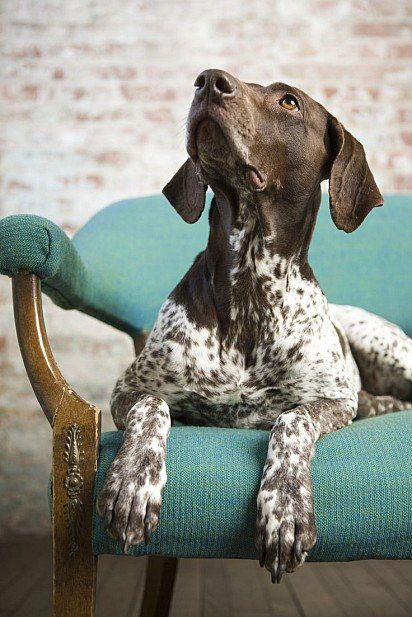

The size and volume of the head of the kurtshaar corresponds to the dimensions and looks harmonious. It has a pronounced outline and a dryish structure. When examining the animal from a certain angle, a wedge-shaped head shape is noticeable. The bones of the skull are relatively wide and give it a slight roundness. The tubercle on the back of the head is expressed moderately. Distinct brow ridges contrast with a shallow furrow on the forehead.
Muzzle
The elongated and very wide muzzle of the shorthaired point gradually tapers towards the nose. It is more pointed in females, while males are distinguished by their “humped nose”. Stop smoothed; the nose protrudes slightly. His earlobe is colored brown, black (in black-roan or black individuals) or beige (in white dogs). Marble pigmentation is also acceptable. The lips are sparse, but create a fold at the corners of the mouth.
Ears
The flat, hanging ears of the dog are set high and wide apart. They have rounded tips that reach the corners of the kurtshaar’s lips. Represent the “golden mean”: not too thin or fleshy. The front part of the ears is adjacent to the cheeks of the animal, if it is not in an excited state.
Eyes
The eyes of the shorthaired pointer are set obliquely and are of medium size. The eyelids fit snugly, creating an oval incision. The iris of the eyes is pigmented with a dark brown tint (in young animals it is light).
Jaws and teeth
The strong jaws of the animal form a scissor bite. The teeth “sit” vertically, the incisors are tightly closed. Complete dental formula available.
Neck
The neck of the shorthaired pointer is quite long in order to harmonize with the appearance of the dog. Gradually expands and set at an angle of 40°. Curves in its upper part, has a convex scruff. The skin on the throat does not sag.
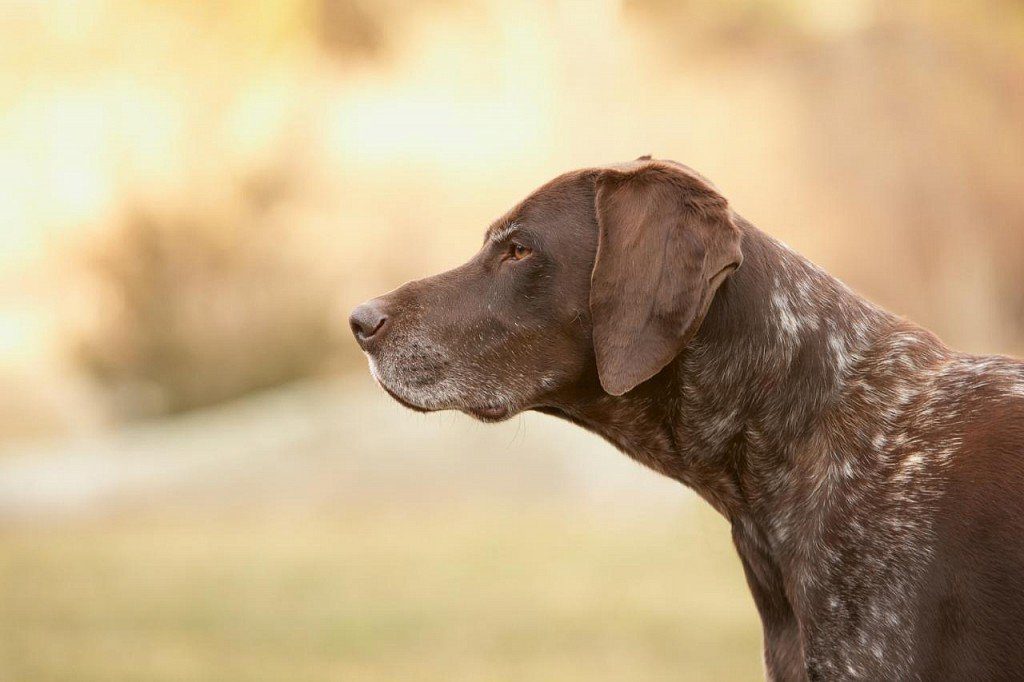

Frame
The kurtshaar has a muscular back, so the processes of the spine are not palpable. The croup is sloping towards the tail, rather broad and long. The chest of the shorthaired pointer is deep and developed. The elbow joints are located at the level of a moderately long sternum. The ribs form a vault. The line of the bottom is smoothly curved, turning into a tucked-up belly.
Tail
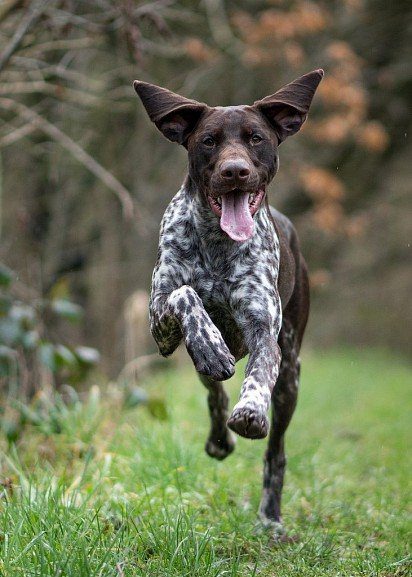

Tapers towards the tip, being thick at the base. Set high, docked at 50% for the participation of the kurtshaar in the hunt. When moving, the tail is carried horizontally, but hangs vertically when the animal is calm.
Forelimbs
The limbs are located under the body of the dog, parallel to each other. The sloping muscular shoulder blades fit snugly to the chest, forming angles of 100 ° with the shoulders. The elbows are deep under the body, forming a small gap. Straight forearms are distinguished by strong bones and muscles. Paster weightless. Paws can be oval or round. The fingers end in claws and rough pads.
Hind limbs
A characteristic feature is the pronounced angles of the joints. The thighs of the shorthaired pointer are very muscular and wide. The tibiae are twice as long as the metatarsus. The latter pass into parallel arched paws. The fingers are collected, ending in strong claws. The pads are hard.
Movement style
The shorthaired pointer moves in a sweeping manner, pushing off with its hind legs and moderately throwing out its front legs. When walking and running, the dog maintains a proud posture. Amble – simultaneous throwing of the hind or forelimbs – is unacceptable.
Coat
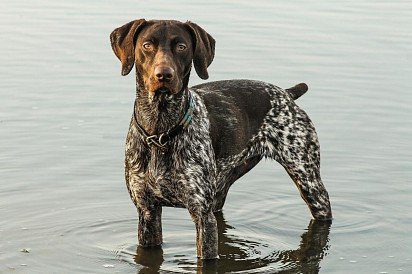

The breed is characterized by a short and hard coat, evenly covering the body. The length of the hairs on the body of the animal reaches 1.5-2 cm. The head and ears of the dog are covered with softer and shorter (up to 1 cm) hair.
Color
The standard provides for the following colors of kurtshaar:
- white with brown spots;
- coffee with gray hair;
- coffee mottled;
- solid coffee;
- coffee-piebald;
- black and white.
The darker the coat color of the shorthaired pointer, the better.
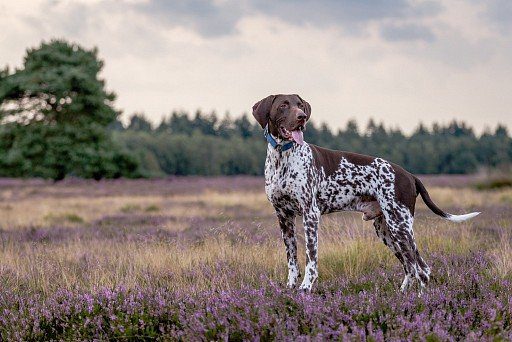

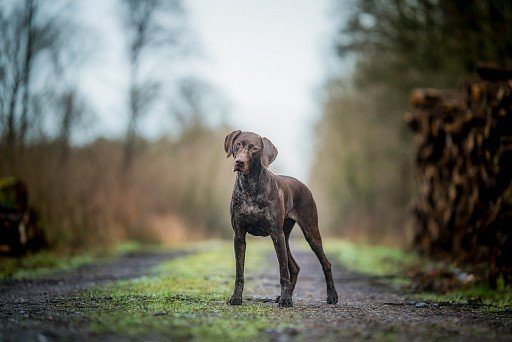

Possible vices
Among the common breed defects are:
- the absence of one or two incisors or molars;
- too thick or thin lips;
- short or long ears;
- light pigmentation of the eyes;
- pronounced bend of the tail;
- too deep chest;
- solid white color;
- slight hunchback;
- shortened croup;
- short muzzle;
- clubfoot;
- suspension.
The disqualifying faults of the kurtshaar are as follows:
- yellow or green iris;
- disturbed sexual dimorphism;
- cowardice or aggressiveness;
- undershot or undershot jaws;
- increased dental formula;
- flat and/or short neck;
- underdeveloped chest;
- a sharp pickup of the abdomen;
- solid white color;
- wavy type of coat;
- rectangular stop;
- cryptorchidism.
Photo of kurtshaar
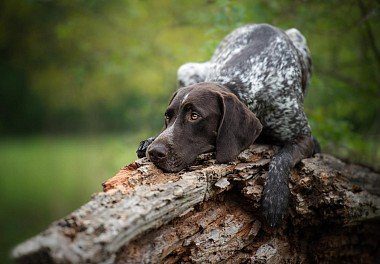

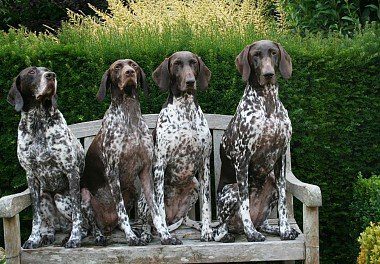

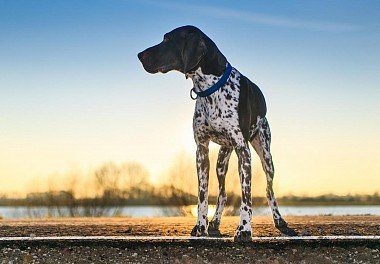

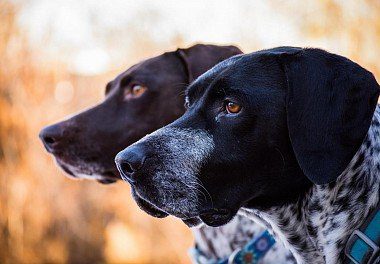

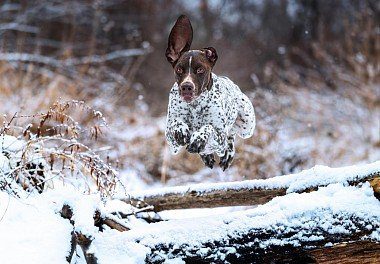

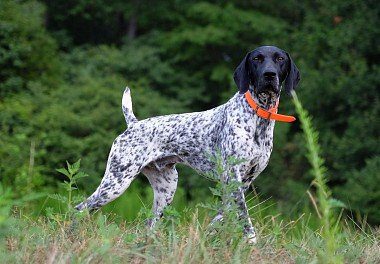

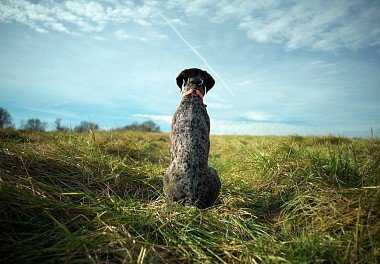

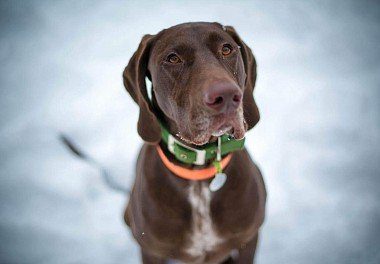

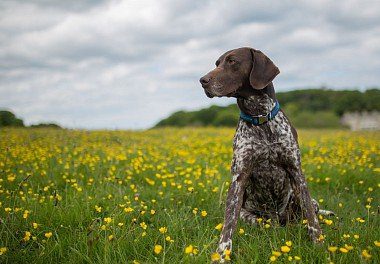

The character of the shorthaired pointer
The breed German shorthaired pointer is unique in every way. This is not only a great hunter, but also a vivid illustration of the proverb: “A dog is a man’s best friend.” Kurzhaars are strongly attached to their family and do not like to leave the owner for a long time. Reading a book, taking a bath or just preparing dinner – be prepared for the fact that the animal will take an active part in any activity.
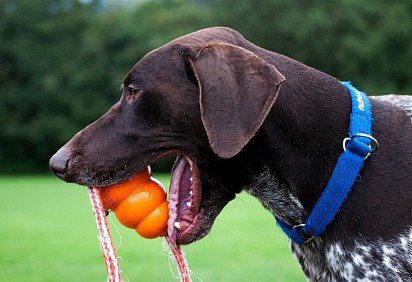

It is worth noting that the strong devotion of the shorthaired pointer can also be a problem. Being left alone for a long time, the dog will not miss the chance to occupy himself with damage to furniture or many hours of howling under the door of the apartment. Opt for another breed if you plan to stay late at work.
The lack of timely socialization will make the shorthaired pointer timid and cowardly. The dog may avoid new family members for a long time, but eventually becomes attached to them. The same trait of character affects strangers. Kurzhaar does not show aggression towards strangers; on the contrary, the dog is playful and friendly (but in moderation). For this reason, representatives of the breed are not the best option for protection. The animal will raise a loud bark, noticing a stranger, but will not be able to bare its fangs and protect the territory entrusted to it.
If you are looking for an active and cheerful friend for your child, pay attention to the kurtshaar! These dogs are great with children and are willing to play with them until they drop, enduring the occasional poking or hugging too tightly. However, you should not leave a small child alone with an animal. Despite their graceful appearance, kurtshaars are strong enough to accidentally knock a baby down.
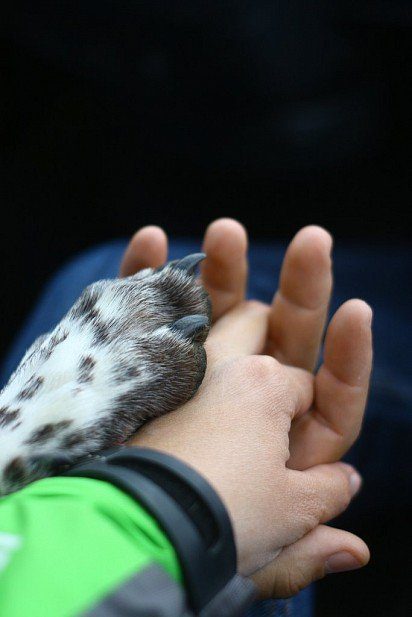

Representatives of the breed, with the exception of poorly socialized, get along well with other pets. These dogs have no desire to demonstrate their superiority and take the place of alpha in an impromptu pack. The only exception is males, which can defiantly growl at each other, sorting out the relationship.
Feel free to leave the kurtshaar alone with a cat or other dog if you consider him well-mannered. However, the company of rabbits, ornamental rats and other small animals should be avoided. You cannot guarantee that the hunting instincts will not wake up at the most inopportune moment. The dog will regard your pet as a toy or prey – and loss will become inevitable.
Shorthaired Pointers are very energetic and active animals. This characteristic sounds from the lips of all dog owners. Provide your pet with daily physical activity for several hours. At the same time, a leisurely walk is not enough: the kurtshaar loves to stretch its paws and therefore prefers to explore the surroundings without a restrictive leash.
It is logical to assume that this breed does not always get along in tight quarters. Kurzhaars are more suitable for keeping in private houses with spacious yards. A heated booth, mouth-watering food and the opportunity to run around your “possessions” at any time of the day will make your pet the happiest on the planet! By limiting the freedom and activity of the shorthaired pointer, you will get an unbalanced dog with unstable behavior and poor health.
When bringing an animal into a spacious yard, do not forget to cut off all escape routes. Kurzhaars tend to run away from home, obeying natural desires to explore an unfamiliar smell. Even the fence won’t stop the dogs. They will easily make a dig or even jump over an obstacle – anything, just to reach the goal. In this case, the developed intelligence of the shorthaired pointer is not a virtue, but a problem. A dog can develop a detailed escape plan even from a fenced area, so do not leave your pet unattended. Of course, the animal will find its way home, but it’s better not to risk your four-legged friend.
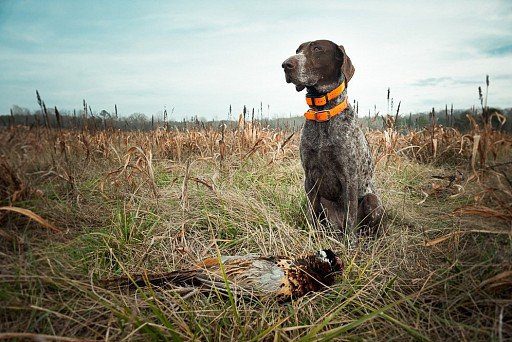

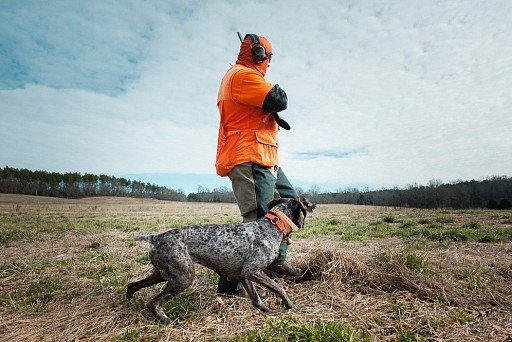

Education and training
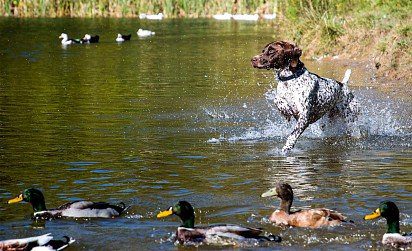

The Kurzhaar is one of the smartest and most easily trained dog breeds. It is important to adhere to the basic rules – and then training a pet will not become a grueling ordeal.
Contrary to the opinion that training should begin as early as possible, in the case of a shorthaired pointer, you should not rush. From the first day your puppy comes into the house, take the time to establish friendly contact with him. Introduce the baby to new people, animals, smells, environment – and then he will grow up balanced and obedient.
The principles of kurtshaar training are “from simple to complex” and “everything at once”. Sounds contradictory, but it’s actually easy. It is recommended to start with basic commands and move on to more intricate ones. At the same time, repeat what you have already learned with your pet: kurtshaars tend to forget what they used to do with a bang.
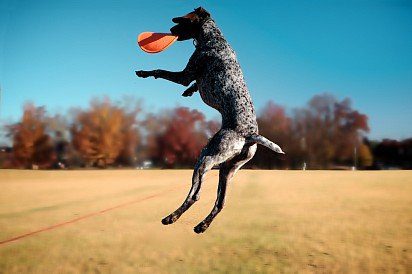

Despite the fact that representatives of this breed rarely show stubbornness, they are very demanding in terms of training. You must be a leader for your pet, otherwise your words will remain without reaction. Kurzhaars already tend to be distracted from the training process, feeling a curious smell and wanting to find its source. This inattention is only exacerbated if the dog does not consider you the undisputed leader.
Do not stick to one plan while training an animal. The kurtshaar will quickly get bored with monotonous activities, and you will encounter a wall of indifference and unwillingness to follow commands. Take control of the situation and prepare a set of various exercises so that the pet can show its intellectual and physical data to the fullest.
If you are not planning to train your dog to hunt, replace these specific commands with more familiar activities. Steeplechase and frisbee chase are the best options for kurtshaar. At the same time, it is important to make it clear that the treat-reward still needs to be earned. This will only reinforce your position as the head of the family in the eyes of the shorthaired pointer.
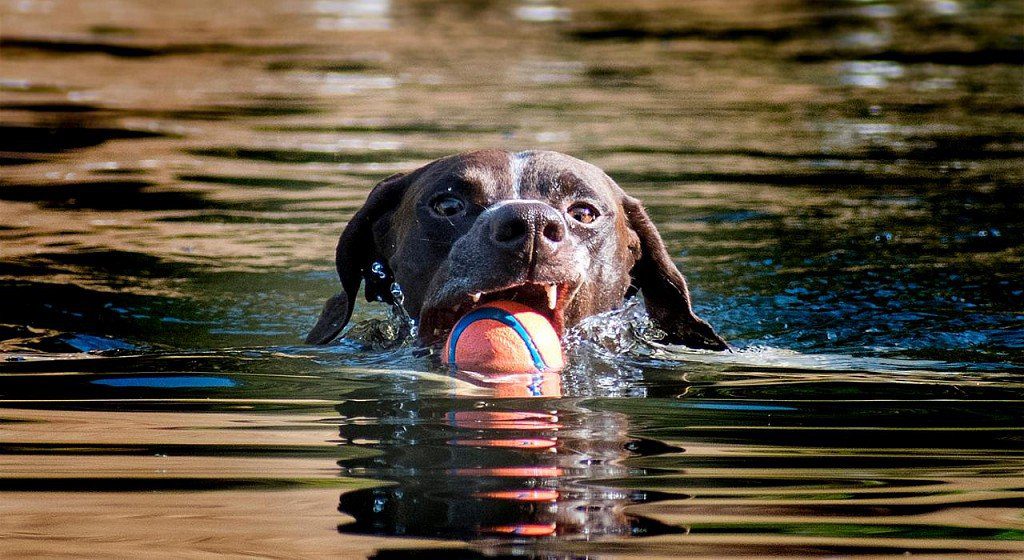

Care and maintenance
Since the kurtshaar is a short-haired dog breed, it does not require regular grooming. Grooming the animal’s coat is limited to brushing it once or twice a week. Use a massage mitt or a hard bristle brush. During the season of heavy molting, it is recommended to carry out the procedure more often.
Swimming is not included in the list of mandatory activities. It is enough to bathe the kurtshaar once a month or as needed. Frequent “bath days” will lead to the loss of the healthy sheen of the coat and its fatty cover, which acts as a barrier against heavy pollution. Use special shampoos for dogs or try dry brushing. This will help your pet keep an attractive appearance. After bathing the kurtshaar, make sure there are no drafts. The animal can catch a cold (especially in winter).
Dust and dirt often accumulate in the ears of a dog: not only after hunting, but also after an active walk, so they also require care. The kurtshaar’s ears must be clean and dry. To achieve this result, arm yourself with a cotton pad or stick. As an aid, use special solutions that can be found in pet stores. It is recommended to clean the ears every day to prevent infectious diseases and inflammation.
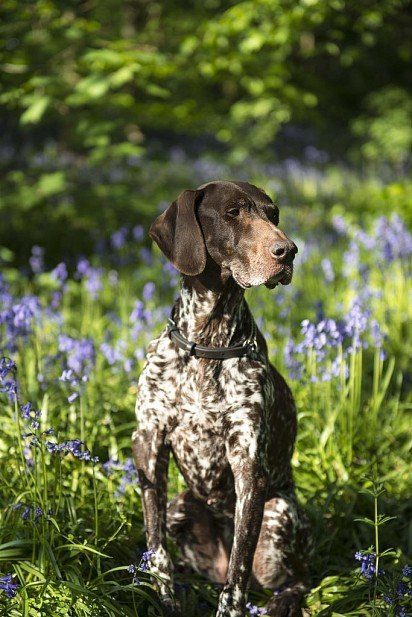

For eye care, a cotton pad and “strong” tea leaves are enough. Remove any secretions carefully. Excessive tearing and sour eyes are alarm bells for contacting a veterinarian.
Energetic and active kurtshaars sharpen their claws naturally, but do not refuse to purchase a nail cutter for large breeds. Once a month, “help” your pet to shorten the claws so that they do not cause discomfort. Smooth out the sharp edges with a nail file and regularly lubricate the paw pads with vegetable oil – and the pet will definitely thank you (albeit in a dog’s “language”).
Pointer teeth need no less care. A hygiene procedure should be carried out twice a week, using a special paste and brush. Fits on a finger too. It is important to teach your dog to hygiene from puppyhood, then your pet will not snap in response to the procedures and will be glad to have the opportunity to spend time with the owner once again.
Shorthaired pointer is a hunting breed that requires a certain diet, in particular animal protein in large quantities. It can be boiled meat, cut into pieces. Offal and cartilage are equally important. Puppies should eat foods high in calcium: milk, cottage cheese, kefir. Thanks to them, the baby will grow up with healthy teeth and bones. By the age of three months, the amount of dairy products should be reduced.
In the diet of the kurtshaar, it is worth including porridge cooked in broth (except pearl barley). Please note that adding salt is highly undesirable. Dilute the bland taste of porridge with fiber-rich foods: pumpkin, zucchini, carrots.
Do not feed your pet:
- fruits with stones;
- raisins and grapes;
- tubular bones;
- yeast dough;
- garlic and onions;
- minced meat;
- raw eggs;
- fatty meat;
- river fish;
- sweets;
- mushrooms.
Puppies up to six months need to be fed five times a day, while giving small portions. After six months, the number of feedings is reduced to three. The kurtshaar must have constant access to drinking water. Use bottled or tap water, letting it pre-brew for 6-8 hours.
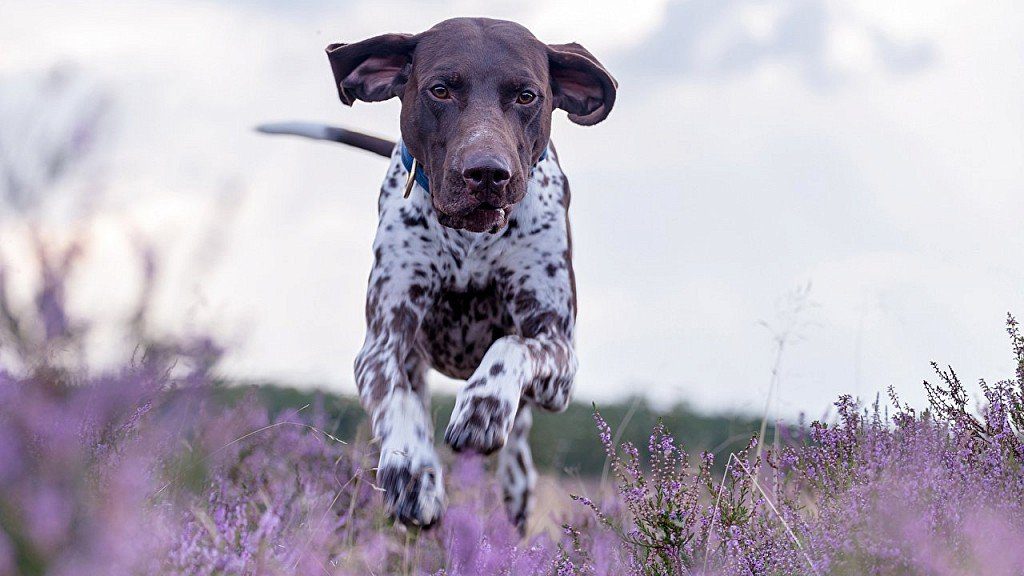

Health and disease of the kurtshaar
The breed is distinguished by endurance and strong immunity, so dogs rarely bother the owner with their malaise. However, some diseases are most common in kurtshaars. Among them:
- joint dysplasia;
- ear infections;
- lack of iodine;
- volvulus;
- piroplasmosis;
- inversion of the eyelids;
- epilepsy;
- melanoma;
- cataract;
- arthritis;
- otitis.
The number of genetic diseases in kurtshaars is small compared to other breeds of dogs. The exception is von Willebrand’s disease, a disease associated with blood.
How to choose a puppy
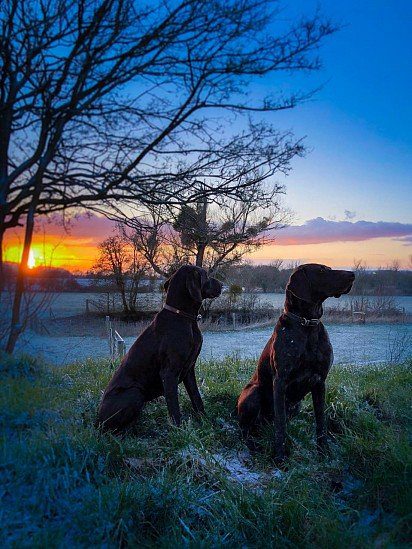

If you want to become the owner of a healthy and harmoniously developed baby, do not purchase it from breeders with a dubious reputation. You should not go to the bird markets, chasing a low price. This savings will translate into regular visits to the veterinary clinic in the future.
Specialized nurseries – that’s where you should go in search of kurtshaar. Pay attention to the gender of the baby: males are more capricious and freedom-loving. Escape from under the nose of the owner is not a problem for them. Males are harder to train due to stubbornness, but it all depends on the nature of a particular dog. Bitches are more devoted and affectionate, rarely feel like going for an unfamiliar smell and leaving the “father’s house”.
The ideal age for purchasing a kurtshaar puppy is 2-6 months. The baby’s psyche is already quite stable, and there will be no problems with adapting to a new family. Before you get acquainted with the litter, ask the breeder to show the parents. Their shortcomings are most often reflected in offspring.
When choosing a future pet, pay attention to the most playful and active puppy. Shiny fur, perky eyes, moderate fatness – all these are indirect signs that the baby will not go to the veterinary clinic the very next day. And, of course, do not forget to listen to your own heart: it will never let you down!
Photos of kurtshaar puppies
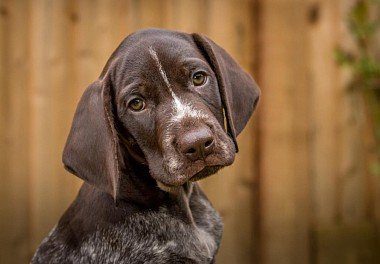

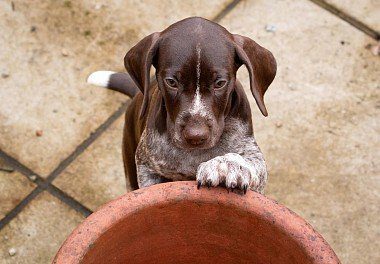

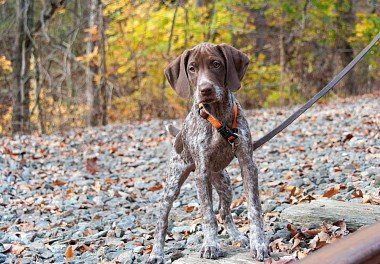

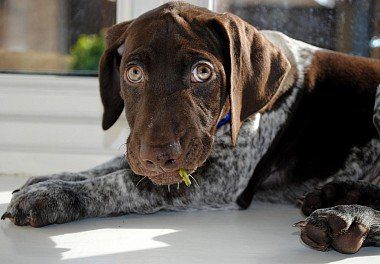

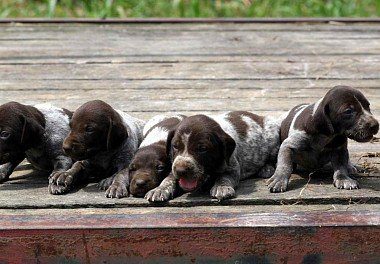

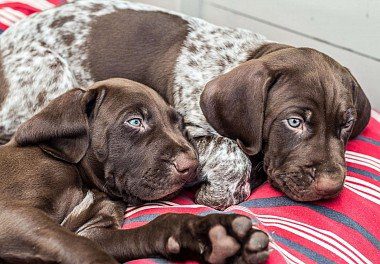

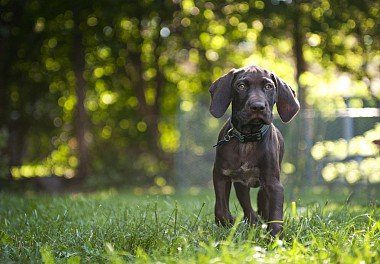

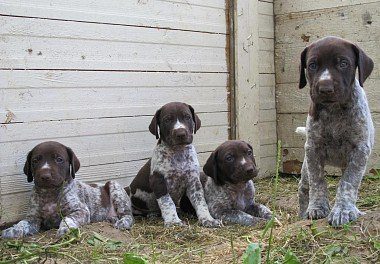

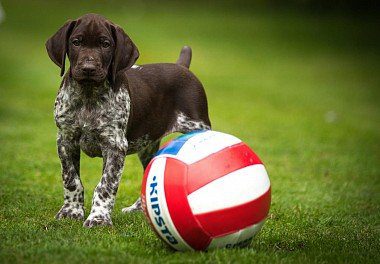

How much is a kurtshaar
Since time immemorial, the shorthaired pointer has been one of the most expensive breeds – largely due to the excellent instincts of the hunter. Now the prices are more democratic. A pet-class dog will cost the future owner 300 – 450$. For a breeding kurtshaar, you will have to pay from 500 to 700$. As for exhibition copies, the price has no limits. The lower limit starts at around 1000$ and above. Think about what you expect from your future pet – and act! In any case, the acquired kurtshaar will become your best and most devoted friend.





